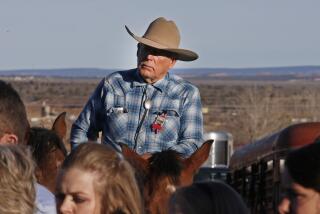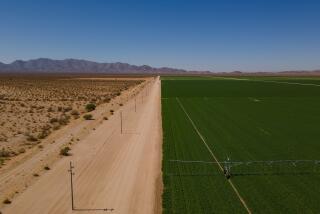Big Hike in Federal Grazing Fees Proposed by Babbitt
- Share via
WASHINGTON — In a bid to reform the management of public lands, the Clinton Administration Monday proposed more than doubling the fees that ranchers pay to graze their herds on federal property and announced new steps to protect the nation’s grasslands from further environmental destruction.
Under a draft policy announced by Interior Secretary Bruce Babbitt, the increase in fees on 272 million acres of land would raise an additional $98.5 million over the next four years. Where ranchers now pay $1.86 per month to graze an “animal unit”--five sheep or a cow and her calf--the new proposal would raise the rate to $4.28 per month over three years.
The new policy marks the second time in six months that the Administration has sought to raise grazing fees and end what many have called a government-sponsored giveaway that has outlived its original purpose of encouraging settlement in the Western states.
In February, the Administration unveiled a plan that would have raised fees much higher. But after lawmakers from Western states protested, the Administration scuttled the proposal. Babbitt said that the plan he announced Monday represented an effort to treat grazing not just as a federal revenue issue but as an environmental issue as well.
“This proposal delivers on President Clinton’s promise that taxpayers will be treated fairly when it comes to the use of their natural resources,” Babbitt told reporters Monday. “It is our belief that the ranching community is getting a good deal and they know it. And the public is getting a fair deal.”
Environmentalists largely welcomed Babbitt’s proposal. James W. Norton, southwest regional director of the Wilderness Society, called it “a step in the right direction” that will help protect and heal federal lands from the effects of overgrazing and poor maintenance.
But many ranchers argued that an increase in fees will have an environmental impact quite different from that intended, driving ranchers off the land and opening the way for shopping malls and housing developments to replace many of the sheep and cattle herds that roam the West.
Babbitt’s remarks begin a period of at least several months during which the public will be invited to comment on the proposal. The announced policy would not begin to take effect until next year at the earliest and Babbitt said that in principle the federal government can implement such changes simply by issuing new regulations. But lawmakers and ranchers can fight it in Congress and the courts and are widely expected to do so.
One bill already introduced in the Senate would limit grazing fee increases to 25%. Even if that legislation fails, ranchers have fought fee increases in the past by taking the federal government to court for denying them access to public lands.
Some 31,000 American ranchers graze their sheep and cattle on lands administered by the Interior Department’s Bureau of Land Management and the Agriculture Department’s Forest Service under a 1937 statute. While grazing fees were last overhauled in 1978, critics of the system contend that little has been done to encourage environmental responsibility on many of the 272 million acres under the care of the two agencies.
In addition to raising fees on land use, Babbitt’s proposal would reform the process by which ranchers are granted permits to graze their livestock on federal land. It would limit the terms of permits to a maximum of 10 years, making them contingent on a rancher’s record of environmental stewardship. And it would replace the Bureau of Land Management’s “grazing advisory boards,” which help review applications and set local standards for federal lands, with a more diverse group of overseers called “resource advisory councils.”
The new councils would include not only ranchers but wildlife managers, fisheries experts, environmentalists and local business owners, Babbitt said. The Wilderness Society’s Norton called this step especially significant in that it would put an end to “a classic case of the fox guarding the chicken coop: ranchers deciding how to develop federal lands for ranching.”
Under Babbitt’s proposal, the federal government, in issuing future permits, also would claim water rights on public lands used for grazing. That would end an era in which ranchers could control access to wells or springs on lands they have leased for grazing.
Babbitt, a former Arizona governor and son of a ranching family, acknowledged that ranching is “a difficult enterprise that rarely leads to huge profits.” And he praised ranchers for helping to define “what it means to be a Westerner.”
Nevertheless, Babbitt added, the government has not been getting a fair price for the use of its rangeland. Government and private groups have assessed the monthly fair-market value of such use at $5 to $12 per animal unit.
“The proposed level will ensure that ranching families continue to make a living off the public’s land, thus preserving an important part of the western economy and western culture,” Babbitt said. “The objective of this is to be fair; we want to keep ranchers on the land,” he added.
Babbitt rejected suggestions that the fee increase will drive some ranchers out of business, noting that grazing payments to the federal government now represent only 5% of the average rancher’s yearly costs. But a recent study conducted by Pepperdine University’s Graduate School of Management concluded that many Montana ranchers who graze their livestock on federal lands already are operating at a financial disadvantage relative to those who graze their animals on private lands.
As the price of grazing livestock on federal lands rises, those disadvantages are likely to increase, driving some from the business, the study said.
More to Read
Get the L.A. Times Politics newsletter
Deeply reported insights into legislation, politics and policy from Sacramento, Washington and beyond. In your inbox twice per week.
You may occasionally receive promotional content from the Los Angeles Times.











